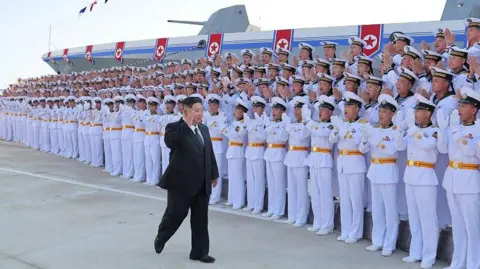The capsizing and subsequent relaunching of a North Korean warship have caught international attention, primarily due to the insight it provides into the inner workings and public narrative of Kim Jong Un’s regime. The vessel capsized during its launch last month, an event that drew considerable media coverage despite no casualties or significant damage reported. The intrigue surrounding the incident is less about the physical mishap and more about Kim Jong Un’s reaction to it.
In a striking display of authority, Kim condemned the incident as “a criminal act that could not be tolerated,” highlighting the perceived blow to national dignity. He swiftly ordered repairs, emphasizing accountability by holding several party officials responsible for the failure. The scandalous incident, observed live by Kim and a crowd at the launch ceremony, could have been viewed as merely a technical failure. However, it offers a lens through which to understand the regime’s priorities regarding military prowess, particularly in enhancing North Korea’s naval capabilities.
According to military analysts, North Korea is sharply focused on developing a navy capable of supporting its nuclear arsenal. For years, despite possessing nuclear weapons and a substantial military force, North Korea has lagged in maritime strength in comparison to neighboring adversaries such as South Korea and Japan. Retired South Korean navy captain Choi Il highlighted this disparity, noting that North Korea’s naval assets, which consist mainly of older submarines and small vessels, cannot match the advanced fleets of its regional rivals.
Since ascending to power, Kim Jong Un has prioritized the establishment of a modern naval fleet, including the integration of nuclear capabilities. The warship involved in the incident is part of this ambition, representing the first of two destroyers constructed within a year, boasting a weight of 5,000 tons and theoretical capabilities to launch nuclear short-range missiles. Such vessels are seen as pivotal in Kim’s long-term strategy to bolster North Korea’s naval deterrent.
The capsizing incident is particularly significant as it underscores the limitations of North Korea’s shipbuilding technology, an embarrassment for the regime, especially in front of an audience that included Kim’s daughter. Observers like Choi have noted that the incident demonstrates not just a setback but a revealing glimpse into North Korea’s construction capabilities, raising concerns about its timeline in building a formidable naval fleet.
Experts specializing in North Korean propaganda suggest that Kim’s very public acknowledgment of the mishap signals a nuanced shift in how the regime manages negative narratives. Rachel Minyoung Lee of the Stimson Center indicated that the regime has, historically, attempted to suppress unfavorable news to maintain an ironclad grip on public perception. However, the increasing flow of information has made it impractical to hide such incidents. Consequently, Kim’s response of publicizing the mishap serves both as a strategy to show accountability and reaffirm governmental efficacy.
This approach is aptly illustrated by Kim’s treatment of other elements surrounding the warship’s construction. Rather than dwelling solely on the incident, officials elevated the narrative of a worker who died during its construction, emphasizing sacrifice and dedication to foster loyalty among citizens. By praising this worker, the regime aimed to draw public sentiment away from the failure and redirect it towards a narrative of commitment and national pride.
The swift relaunching of the warship, completed in just three weeks—a timeframe surprising to naval analysts—has turned what could have been seen as a significant embarrassment into a potential political victory for Kim. It encapsulates his strategic maneuvering in portraying resilience and capability within the state apparatus.
Moreover, experts like Kim Dong-yup have noted that the incident plays right into Kim’s broader strategy of demonstrating progress in military advancements, particularly the establishment of a nuclear-armed navy projected to operate beyond domestic waters. The implications are considerable, as they signify a regime that is not only ambitious but potentially close to achieving its military objectives despite initial skepticism from the international community.
In conclusion, the saga surrounding the warship’s capsizing and relaunch paints a complex picture of a regime determined to exhibit strength amid setbacks. As North Korea embarks on its journey towards becoming a formidable maritime force, vigilance is warranted to monitor the advancements being made under Kim Jong Un’s leadership.



